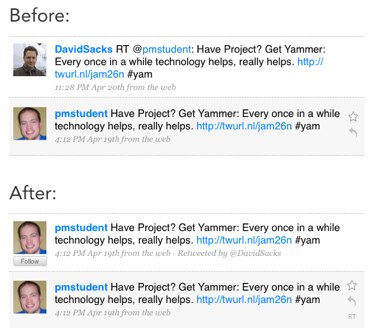
Editor’s note: This is a guest post by David Sacks, the Founder and CEO of Yammer and Geni. Previously he was the COO of PayPal and produced the Academy Award-nominated movie “Thank You For Smoking.” Sacks says he’s incorporating the retweet feature into Yammer, his “Twitter for the enterprise” product that launched at TechCrunch50 last year. Sacks’ Twitter username is @DavidSacks
While there are many new features that Twitter could launch, the most powerful are likely to be based on behaviors that users have invented themselves.
That’s exactly what happened with @replies. Users started addressing each other by their @usernames. Twitter noticed and officially supported the feature. As a result, Twitter is on its way to becoming the discussion board for the web.
There is one other user convention with that kind of potential: Retweet.
A retweet occurs when a user reposts an interesting tweet. As with @replies, users established the notation organically: you type ‘RT’ followed by the @username of the original author and then the message.

The problem is friction. You have to copy & paste the message and then the author’s username. Frequently you have to edit the original message because the extra meta-data pushes it over 140 characters. Because of the accumulation of meta-data, retweets are even harder to retweet. This means that interesting messages don’t spread more than a generation or two.
Retweet support built into clients like Tweetdeck is only a partial solution. It eliminates the need to copy & paste messages but not to edit the original.
Twitter should officially support this feature by adding a ‘RT’ option to messages. Clicking this button would repost the original message in your followers’ feeds. The reposted message would appear just as you saw it (except for a tagline showing who retweeted it), and could itself be retweeted. (See my ‘Before’ and ‘After’ screenshot.)
The ability to retweet retweets is critical because it means that messages could spread throughout the twittersphere frictionlessly. I believe this would make Twitter the leading way that memes spread in our culture.
Twitter could accelerate this phenomenon by surfacing analytics about the most retweeted messages, allowing users to see the ideas (and links) that are spreading fastest throughout the world or in their local networks.
One other suggestion: A follow button appearing under the original author’s avatar in a retweet would make it easy to follow that person. Thus retweet would ensure widespread distribution not just of interesting content but also of interesting people. This would help level the “celebrity” bias on Twitter, allowing regular people to quickly build a following by posting interesting messages. In the absence of such a feature, many people conclude that it’s too hard to get discovered if you’re not a celebrity.
Like search and @replies, retweet plays to Twitter’s core strengths — discoverability and easy sharing. In the war between sharing platforms, it’s hard to see how Facebook could copy this feature, because its privacy settings would prevent the frictionless spread of content.
If Twitter becomes the dominant platform for discovering and sharing information when privacy is not important (including most status updates and all links), Facebook might suddenly look like a small subset of the sharing universe, reserved primarily for private news and media sharing.